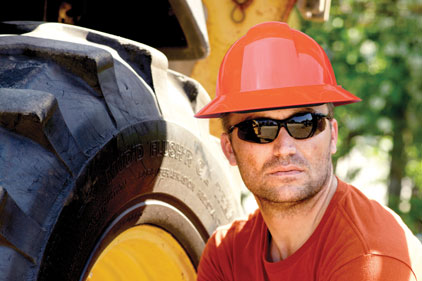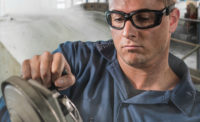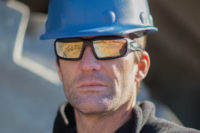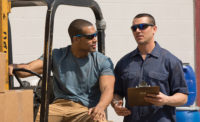Repeated or extended exposure to bright light, whether natural or artificial, can cause strain and damage to the eyes. Over time, exposure to the sun’s invisible ultraviolet (UV) rays can lead to macular degeneration — a leading cause of vision loss for older Americans — as well as cataracts, skin cancer around the eyelids, corneal sunburn and other temporary and permanent vision problems.
The World Health Organization estimates that approximately 16 million people worldwide are currently blind as a result of cataracts, and as many as 20 percent of those cases may be due to UV exposure.
Individuals rely on their eyes as their primary means of experiencing the world. Furthermore, they rely on vision to be productive members of the workforce and to make a living. Clear vision also plays a vital role in helping individuals keep out of harm’s way in the workplace. Protecting workers’ eyes from harmful light as well as from obscured vision caused by humidity is important. This article discusses key considerations for selecting protective eyewear suited for these invisible — and often overlooked — summertime hazards.
Sunlight and glare
Safety managers may be surprised to learn that most safety eyewear — whether the lenses are clear or tinted — provides 99.9 percent protection from UVA and UVB light. When working outdoors, however, workers are exposed not only to UV light, but also to bright sunlight and glare. These hazards can result in discomfort and eye fatigue.
Safety eyewear with tinted lenses offers suitable protection against these additional hazards and is available in standard gray, brown or mirrored tints commonly found in street wear sunglasses. Each lens tint is made using unique dyes that enable the lens to manipulate light and to reduce its intensity. Most common lens tints are suitable for a variety of outdoor applications and may be selected based on user preference.
While tinted lenses reduce brightness and glare, when it comes to protection from extreme glare, polarized lenses offer increased benefits. Glare is particularly intense when light is reflected off of water, sand and snow, as well as glass, sheet metal, light concrete or any reflective surface.
Through a special manufacturing process, polarized lenses not only help eliminate glare but also improve visual acuity through enhanced contrast. When employers outfit their outdoor workforce with polarized lenses, their workers benefit from reduced exposure to harmful light, eliminating eye strain and prolonging comfortable vision.
For workers who frequently transition between indoor and outdoor settings, switching out safety eyewear from dark to clear lenses is a common solution. However, this approach doubles the amount of PPE they are using. During the time it takes for the eyes to adjust to extreme changes in light — up to several minutes — workers’ vision is compromised, heightening their risk of injury. Furthermore, the darkly-tinted lenses worn outdoors may not be suitable for use in dimmer indoor light — and may cause a dangerous reduction in visibility.
For some workers, photochromic lenses may offer an ideal solution. Through a technologically advanced chemical reaction, photochromic lenses respond to UV and automatically transition from clear during indoor use to a darkened tint when outdoors. There are some limitations to these types of lenses. Photochromic lenses take several seconds to fully transition from tinted to clear and will not function in vehicles to the extent that UV protection is in the windows and windshields. Careful consideration of the actual usage must be made when selecting eyewear with photochromic lenses.
Humidity and fog
Fogging occurs when tiny droplets of water condense on the lens. In humid conditions, it can affect both the inside and outside of the lens. In applications where a worker’s body temperature rises above the temperature of the environment, fogging occurs on the inside of the lens. Fogging is also common when workers transition between extremes in temperature and humidity, such as from a refrigerated storage unit to a hot loading dock.
Fogging on safety lenses poses significant risks to worker safety. When lenses become foggy, workers’ vision is blurred leaving them vulnerable to injury. Plus, to combat fogging, a worker may remove safety eyewear to wipe it dry or, worse yet, choose to leave it off to avoid obscured vision altogether. In hot and humid conditions, consider anti-fog coatings with combined hydrophilic and hydrophobic properties that promote a clear view even in the most extreme environments.
Sweat and chemicals
Another feature of safety eyewear that can deliver advantages in hot or humid work environments is the brow guard. Often incorporated as a safety feature to prevent debris from entering the eyes, some brow guards are designed with materials specifically made to absorb moisture or wick it away from the user’s brow. Other designs help by channeling sweat away from the eyes. In high-temperature applications, brow guards can be a useful tool in helping keep sweat — which carries salt, sunscreen, bug spray and other harmful elements — out of workers’ eyes.
Fashion as well as function
In summer weather, sunglasses are a staple, worn not only for protecting the eyes from sun and glare but also as a fashion accessory. Beware of street wear sunglasses on the work site though. Because they are not rated to protect from impact, regular sunglasses can prove as dangerous as not wearing any safety eyewear on the job. According to OSHA, employers are required to provide workers with protective eyewear that meets the ANSI Z87.1-2010 standard for impact protection; such eyewear must be marked with “Z87” on every major component.
Despite national safety requirements, fashion does not have to take a back seat when it comes to protective eyewear. In fact, style plays a proven role in supporting compliance: studies show that workers are more likely to wear safety eyewear when it feels stylish rather than cumbersome. Style options abound in the safety eyewear category and include sport styling and wraparound designs; some manufacturers even offer licensed lines from leading sport and style brand icons.
Once you have selected the frames and lenses best suited for the workforce, it is important to take proper care of your investment. Remember that, in summer, eyewear is exposed to sweat, salt and chemicals that can degrade the eyewear over time. For best results and long-lasting performance, follow the manufacturer’s recommendations for proper cleaning and care of your safety eyewear.
Summertime hazards such as intense light and humidity are easily overlooked in safety audits. However, nothing is more important than protecting workers’ vision from visible and invisible hazards alike. By providing the proper lens tints, anti-fog coatings, brow guard features and style options, safety managers can reduce injuries, prolong eye health and encourage safety eyewear use. When this is achieved, employers benefit from a stronger culture of safety — a benefit that everyone can clearly see.



